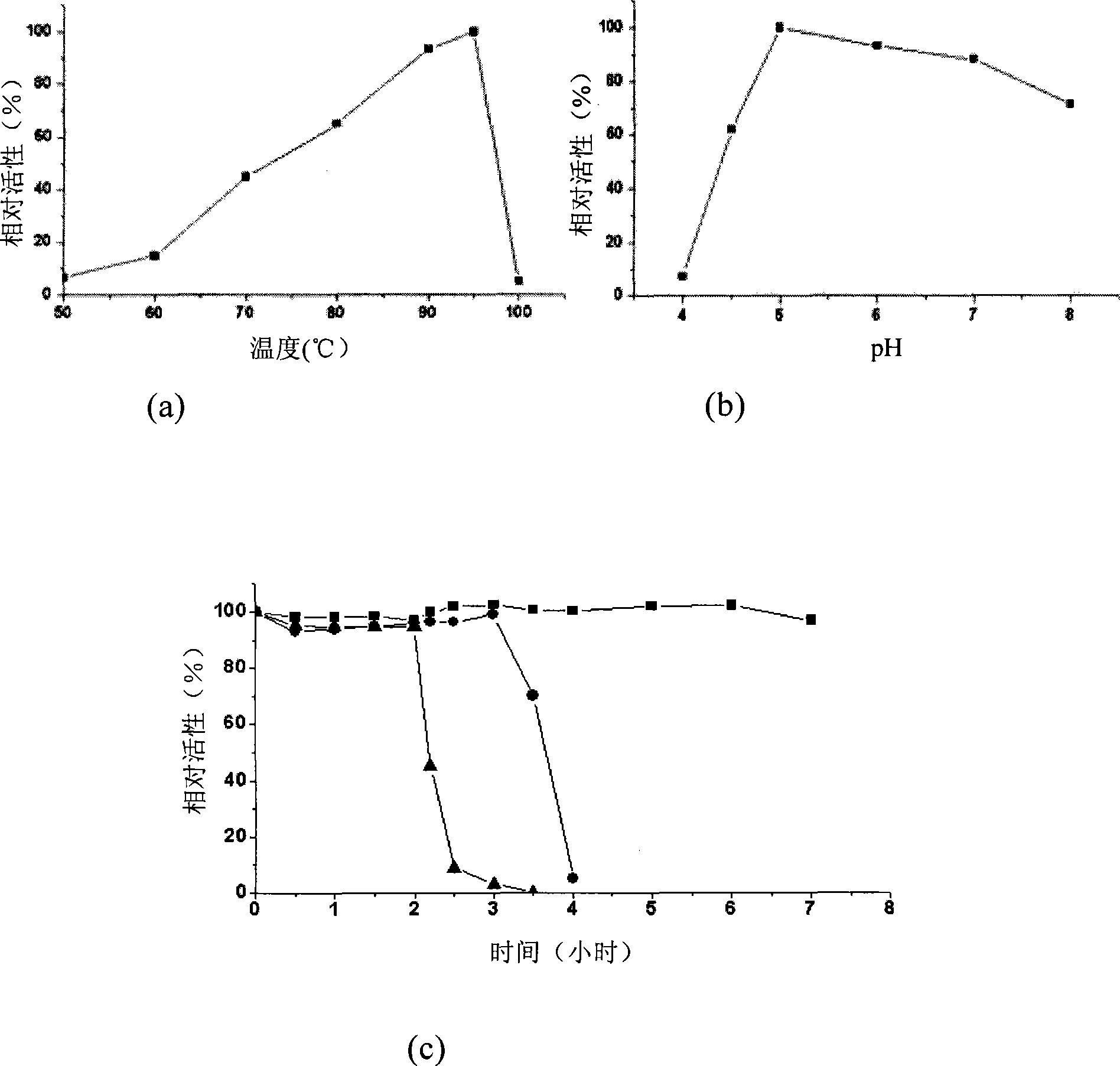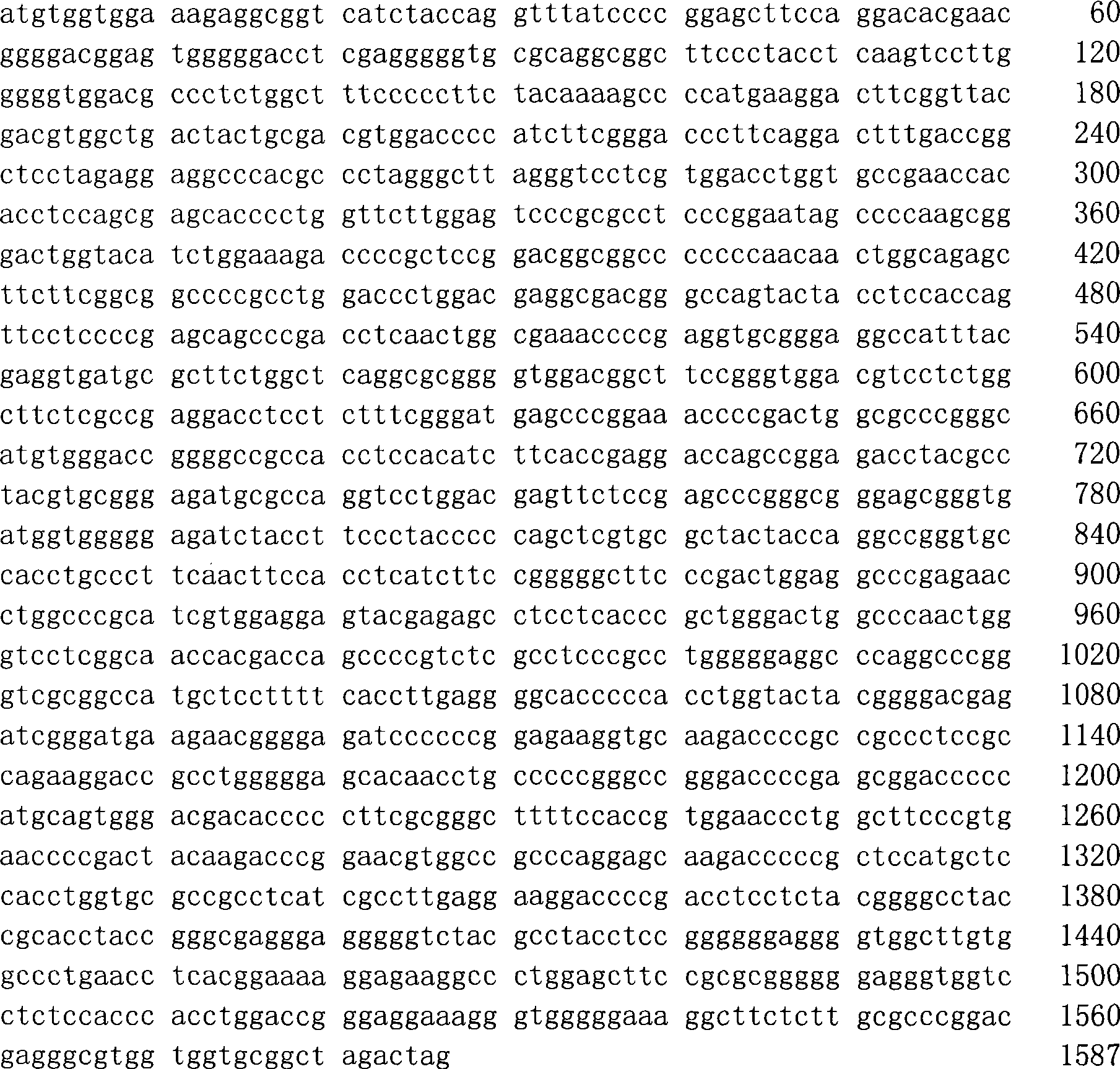Alpha-glucosidase, gene thereof, preparation method, vector and host cell
A technology of glucosidase and recombinant host cells, which is applied in the fields of botanical equipment and methods, microorganism-based methods, biochemical equipment and methods, etc., can solve the problems of low enzyme activity, limited application, limited expression, etc. High-efficiency expression, strong sucrose hydrolysis function, high temperature and thermal stability
- Summary
- Abstract
- Description
- Claims
- Application Information
AI Technical Summary
Problems solved by technology
Method used
Image
Examples
Embodiment 1
[0038] Example 1. Construction of the recombinant cloning vector pGEM-TGlu plasmid containing the sequence shown in SEQ ID: NO.1 and the transformed strain DH5α (pGEM-TGlu)
[0039] Collect 2L of water sample from Toad’s mouth hot spring (pH8, temperature 78℃) in Tengchong, Yunnan, filter through 0.22μm microporous membrane (Milipore) to collect the bacteria in the water sample, use STE buffer (0.1M NaCl; 10mM Tris) -HCl pH8.0; 1mM EDTA pH8.0) wash the bacteria on the filter membrane and centrifuge at 4000rpm for 10 minutes to obtain the fresh wet weight of the bacteria about 0.5g. UltraClean for bacterial pellet TM Soil DNAKit extracts the total DNA solution (100 μl, 0.4 μg / μl), and determines the absorbance ratio of the total DNA solution: A260 / A280=1.947, A260 / A230=2.15. Take 0.2μl of the above total DNA solution as a template, and design primers based on the upstream and downstream sequence information of the α-glycosidase in the Thermus thermophilus HB27 genome sequence in th...
Embodiment 2
[0040] Example 2. Construction of α-glucosidase expression vector and transformed strain:
[0041] Both pGEM-TGlu plasmid and plasmid pET28a were digested with Nhe I and HindIII (50μl digestion system containing 20μg plasmid, 20U each of the two restriction enzymes, digestion at 37°C for 4 hours), and cut the gel by agarose electrophoresis After recovering the target insert and pET28a digested fragments (recovered separately in 20μl deionized water), ligate the two digested products (5μl ligation system contains 1μl pET28a digested fragment, 3μl target insert, 1μl promega T4DNA ligase , Connect overnight at 16°C), construct a pETGlu recombinant expression vector, take 2μl of the ligation product and transform it into E. coli BL21 (DE3) by electric shock (voltage 1.8KV, capacitance 25μF, electric shock time 3ms) to obtain the recombinant expression containing SEQ ID: NO.1 The vector transformed strain BL21(DE3)(pETGlu).
Embodiment 3
[0042] Example 3. Preparation of mutants of α-glucosidase gene and construction of transformed strains
[0043] Using Stratagene's site-directed mutagenesis kit (QuikChange site-directedmutagenesis kit), using the expression vector pETGlu of Example 2 as a template, referring to the instructions, by introducing mutant bases in the primers and performing PCR amplification to SEQ ID: NO. 1 Carry out the following 4 kinds of site-directed mutations respectively: (1) A mutation at position 211 to G; (2) a mutation from G at position 272 to A; (3) a mutation from C at position 1546 to T, and a mutation from T at position 1571 to C (4) A mutation at position 211 to G, G at position 272 to A, C at position 1546 to T, and T at position 1571 to C. The mutant products obtained were digested with Dpn I respectively (20μl system contains 15μl PCR product and 5U Dpn I, digested at 37°C for 2 hours), and 2μl each was electrotransformed (conditions are the same as in Example 2) E. coli XL1-Blue ...
PUM
 Login to View More
Login to View More Abstract
Description
Claims
Application Information
 Login to View More
Login to View More - R&D
- Intellectual Property
- Life Sciences
- Materials
- Tech Scout
- Unparalleled Data Quality
- Higher Quality Content
- 60% Fewer Hallucinations
Browse by: Latest US Patents, China's latest patents, Technical Efficacy Thesaurus, Application Domain, Technology Topic, Popular Technical Reports.
© 2025 PatSnap. All rights reserved.Legal|Privacy policy|Modern Slavery Act Transparency Statement|Sitemap|About US| Contact US: help@patsnap.com



